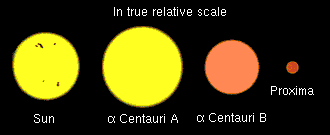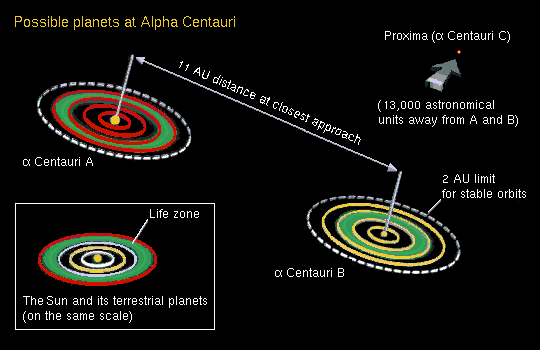
Last Update 15th October '97
Visible only from latitudes south of about 25° the star we call Alpha Centauri lies 4.35 light-years from the Sun. But it is actually a triple star system. The two brightest components Alpha Centauri A and B form a binary. They orbit each other in 80 years with a mean separation of 23 astronomical units (1 astronomical unit = 1 AU = distance between the Sun and Earth). The third member of the system Alpha Centauri C lies 13,000 AU from A and B, or 400 times the distance between the Sun and Neptune. This is so far that it is not known whether Alpha Centauri C is really bound to A and B, or if it will have left the system in some million years. Alpha Centauri C lies measurably closer to us than the other two: It is only 4.22 light-years away, and it is the nearest individual star to the Sun. Because of this proximity, Alpha Centauri C is also called Proxima (Centauri).

Alpha Centauri A is a yellow star with a spectral type of G2, exactly the same as the Sun's. Therefore its temperature and color also match those of the Sun. Alpha Centauri B is an orange star with a spectral type of K1. Whereas Alpha Centauri A and B are stars like the Sun, Proxima is a dim red dwarf with a spectral type of M5 - much fainter, cooler, and smaller than the Sun. Proxima is so faint that astronomers did not discover it until 1915.
| The Sun And Its Nearest Neighbours | Sun | Alpha Centauri A | Alpha Centauri B | Proxima |
| Color | Yellow | Yellow | Orange | Red |
| Spectral type | G2 | G2 | K1 | M5 |
| Temperature | 5800 K | 5800 K | 5300 K | 2700 K |
| Mass | 1.00 | 1.09 | 0.90 | 0.1 |
| Radius | 1.00 | 1.2 | 0.8 | 0.2 |
| Brightness | 1.00 | 1.54 | 0.44 | 0.00006 |
| Distance (light-years) | 0.00 | 4.35 | 4.35 | 4.22 |
| Age (billion years) | 4.6 | 5 - 6 | 5 - 6 | ~1? |
Alpha Centauri is a special place, because it may offer life conditions similar to our solar system. A star must pass five tests before we can call it a promising place for terrestrial life as we know it. Most stars in the Galaxy would fail. In the case of Alpha Centauri, however, we see that Alpha Centauri A passes all five tests, Alpha Centauri B passes either all but one, and only Proxima Centauri flunks out.
The first criterion is to ensure a star's maturity and stability, which means it has to be on the main sequence. Main-sequence stars fuse hydrogen into helium at their cores, generating light and heat. Because hydrogen is so abundant in stars, most of them stay on the main sequence a long time, giving life a chance to evolve. The Sun and all three components of Alpha Centauri pass this test.
The second test is much tougher, however, we want the star to have the right spectral type, because this determines how much energy a star emits. The hotter stars - those with spectral types O, B, A, and early F - are no good because they burn out fast and die quickly. The cooler stars - those with spectral types M and late K - may not produce enough energy to sustain life, for instance they may not permit the existance of liquid water on their planets. Between the stars that are too hot and those that are too cool, we find the stars that are just right. As our existance proves, yellow G-type stars like the Sun can give rise to life. Late (cool) F stars and early (hot) K stars may be fine too. Luckily, Alpha Centauri A passes this test with bravour, as it is of the same class as our Sun. Alpha Centauri B is a K1 star, so it is hotter and brighter than most K stars, therefore it may pass this test or it may not. And the red dwarf Proxima Centauri seems to be a hopeless case.
For the third test, a system must demonstrate stable conditions. The star's brightness must not vary so much that the star would alternately freeze and fry any life that does manage to develop around it. But because Alpha Centauri A and B form a binary pair there's a further issue. How much does the light received by the planets of one star vary as the other star revolves around it ? During their 80-year orbit, the separation between A and B changes from 11 AU to 35 AU. As viewed from the planets of one star, the brightness of the other increases as the stars approach and decreases as the stars recede. Fortunately, the variation is too small to matter, and Alpha Centauri A and B pass this test. However, Proxima fails this test, too. Like many red dwarfs it is a flare star, prone to outbursts that cause its light to double or triple in just a few minutes.
The fourth condition concerns the stars' ages. The Sun is about 4.6 billion years old, so on Earth life had enough time to develop. A star must be old enough to give life a chance to evolve. Remarkably, Alpha Centauri A and B are even older than the Sun, they have an age of 5 to 6 billion years, therefore they pass this test with glamour, too. Proxima, however, may be only a billion years or so old, then it fails this test, too.
And the fifth and final test: Do the stars have enough heavy elements - such as carbon, nitrogen, oxygen and iron - that biological life needs ? Like most stars, the Sun is primarily hydrogen and helium, but 2 percent of the Sun's weight is metals. (Astronomers call all elements heavier than helium "metals".) Although 2 percent may not sound a lot, it is enough to build rocky planets and to give rise to us. And again, fortunately, Alpha Centauri A and B pass this test. They are metal-rich stars.
Now to the final question. Do we find at Alpha Centauri warm, rocky planets like Earth, full of liquid water ? Unfortunately, we don't know yet whether Alpha Centauri even has planets or not. What we know is that in a binary system the planets must not be too far away from a particular star, or else their orbits become unstable. If the distance exceeds about one fifth of the closest approach of the two stars then the second member of the binary star fatally disturbes the orbit of the planet. For the binary Alpha Centauri A and B, their closest approach is 11 AU, so the limit for planetary orbits is at about 2 astronomical units. Comparing with our system, we see that both Alpha Centauri A and B might hold four inner planets like we have Mercury (0.4 AU), Venus (0.7 AU), Earth (1 AU) and Mars (1.5 AU). Therefore, both Alpha Centauri A and B might have one or two planets in the life zone where liquid water is possible.
| Terrestrial Life Conditions: Questions for Any Star | Sun | Alpha Centauri A | Alpha Centauri B | Proxima |
| On the main sequence ? | Yes | Yes | Yes | Yes |
| Of the right spectral type ? | Yes | Yes | Maybe | No |
| Constant in brightness ? | Yes | Yes | Yes | No |
| Old enough ? | Yes | Yes | Yes | No? |
| Rich in metals ? | Yes | Yes | Yes | ? |
| Has stable planetary orbits ? | Yes | Yes | Yes | Yes |
| Could planets form ? | Yes | ? | ? | Yes |
| Do planets actually exist ? | Yes | ? | ? | ? |
| Small rocky planets possible ? | Yes | Yes | Yes | Yes? |
| Planets in the life zone ? | Yes | Maybe | Maybe | No |

K.Croswell:
"Does Alpha Centauri have intelligent life ?",
Astronomy 19 (1991), No. 4, pgs. 28 - 37